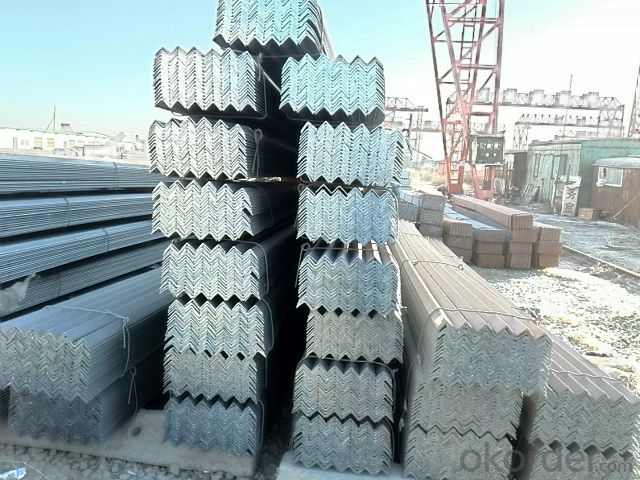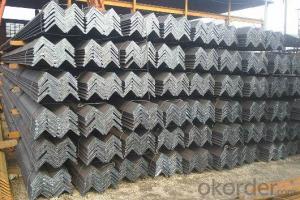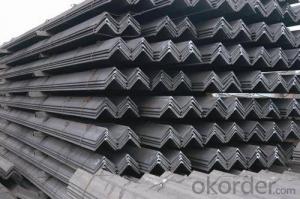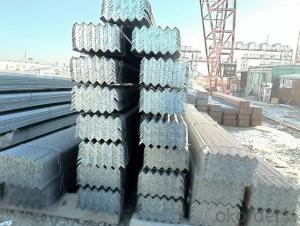Hot Rolled Angle Steel Bars with Highest Quality
- Loading Port:
- Tianjin
- Payment Terms:
- TT OR LC
- Min Order Qty:
- 25 m.t
- Supply Capability:
- 10000 m.t/month
OKorder Service Pledge
OKorder Financial Service
You Might Also Like
OKorder is offering Hot Rolled Equal Angles at great prices with worldwide shipping. Our supplier is a world-class manufacturer of steel, with our products utilized the world over. OKorder annually supplies products to European, North American and Asian markets. We provide quotations within 24 hours of receiving an inquiry and guarantee competitive prices.
Product Applications:
Hot Rolled Equal Angles are ideal for structural applications and are widely used in the construction of buildings and bridges, and the manufacturing, petrochemical, and transportation industries.
Product Advantages:
OKorder's Hot Rolled Equal Angles are durable, strong, and resist corrosion.
Main Product Features:
· Premium quality
· Prompt delivery & seaworthy packing (30 days after receiving deposit)
· Corrosion resistance
· Can be recycled and reused
· Mill test certification
· Professional Service
· Competitive pricing
Product Specifications:
Manufacture: Hot rolled
Grade: Q195 – 235
Certificates: ISO, SGS, BV, CIQ
Length: 6m – 12m, as per customer request
Packaging: Export packing, nude packing, bundled
Sizes: 25mm-250mm | ||
a*t | ||
25*2.5-4.0 | 70*6.0-9.0 | 130*9.0-15 |
30*2.5-6.6 | 75*6.0-9.0 | 140*10-14 |
36*3.0-5.0 | 80*5.0-10 | 150*10-20 |
38*2.3-6.0 | 90*7.0-10 | 160*10-16 |
40*3.0-5.0 | 100*6.0-12 | 175*12-15 |
45*4.0-6.0 | 110*8.0-10 | 180*12-18 |
50*4.0-6.0 | 120*6.0-15 | 200*14-25 |
60*4.0-8.0 | 125*8.0-14 | 250*25 |
FAQ:
Q1: Why buy Materials & Equipment from OKorder.com?
A1: All products offered byOKorder.com are carefully selected from China's most reliable manufacturing enterprises. Through its ISO certifications, OKorder.com adheres to the highest standards and a commitment to supply chain safety and customer satisfaction.
Q2: Can fit in the containers of 20fts the steel beams of 6M?
A2: No problem, we can put them into the containers in sideling form.
Q3: Can stainless steel rust?
A3: Stainless does not "rust" as you think of regular steel rusting with a red oxide on the surface that flakes off. If you see red rust it is probably due to some iron particles that have contaminated the surface of the stainless steel and it is these iron particles that are rusting. Look at the source of the rusting and see if you can remove it from the surface.
Images:


- Q:What are the different methods of fire protection for steel angles?
- Depending on specific requirements and regulations, there exist several methods for fire protection of steel angles. Some commonly used methods include: 1. Passive Fire Protection: Fire-resistant materials, such as fire-resistant coatings, fireproofing sprays, or intumescent paints, are directly applied to the steel angles. These coatings serve to delay fire spread and provide insulation, safeguarding the steel angles from high temperatures during a fire. 2. Encasement: Steel angles can be enclosed in fire-resistant materials like concrete or gypsum board. This creates a barrier that prevents the fire from reaching temperatures that could result in structural failure. 3. Fireproofing Systems: Fire-resistant boards or panels are affixed to the steel angles, forming fireproofing systems. These systems offer insulation and protection against fire, slowing down the heating process and maintaining the structural integrity of the steel angles for an extended period. 4. Sprinkler Systems: The installation of sprinkler systems is also an effective fire protection measure for steel angles. These systems are designed to detect and suppress fires by releasing water or fire-suppressing agents upon activation. By swiftly extinguishing the fire, sprinklers can prevent the steel angles from reaching critical temperatures. 5. Fire-resistant barriers: Fire-resistant walls or curtains can be employed as barriers to separate steel angles from potential fire sources. These barriers aid in containing the fire and preventing its spread to the steel angles, providing an additional layer of protection. To determine the most suitable method of fire protection for steel angles in a specific setting, it is crucial to consult fire protection experts, engineers, and local building codes. Factors such as building type, fire safety requirements, and the level of fire risk involved may influence the choice of method.
- Q:What are the common surface treatments used for steel angles?
- The common surface treatments used for steel angles include galvanization, powder coating, and painting.
- Q:Can steel angles be used for electrical conduits or cable trays?
- Depending on project requirements and regulations, steel angles can serve as support structures for electrical conduits or cable trays. These angles are well-known for their strength and durability, making them commonly used as structural supports. However, when considering their use for electrical conduits or cable trays, it is imperative to ensure that they meet the necessary electrical and safety codes. Electrical conduits and cable trays are specifically designed to house and protect electrical wires or cables in a safe manner. These systems must be capable of withstanding the weight of the cables, providing proper grounding, and offering sufficient protection against physical damage, moisture, and other potential hazards. Steel angles can be employed as support structures for electrical conduits or cable trays, providing a robust framework for the installation and securement of the system. However, it is crucial to ensure that the steel angles are effectively grounded, insulated, and guarded against corrosion to meet all electrical safety standards. Furthermore, the selection of the appropriate size and dimensions for the steel angles should be based on the weight and size of the cables or wires being installed. To guarantee compliance with all necessary requirements, it is important to consult with electrical engineers or professionals who are familiar with local electrical codes and standards. In conclusion, while steel angles can be utilized for electrical conduits or cable trays, it is essential to carefully consider the specific requirements and regulations of the project to ensure electrical safety and compliance.
- Q:How do you design bracing using steel angles?
- Designing bracing using steel angles involves determining the required strength and stiffness of the bracing members, selecting appropriate steel angles based on their load-bearing capacities, and arranging them in a configuration that effectively resists the applied forces and moments. The design process typically includes analyzing the structure's loadings, determining the required bracing forces, calculating the required cross-sectional area of the steel angles, and verifying the design against relevant design codes and standards. Additionally, considerations such as connection details and fabrication constraints also play a role in designing bracing using steel angles.
- Q:Can steel angles be used in signage?
- Yes, steel angles can be used in signage. Steel angles are commonly used as a structural support for signs, providing stability and durability. They can be easily welded or bolted together to create a sturdy framework for mounting signage materials such as panels, letters, or graphics. Additionally, steel angles offer versatility in terms of design options, allowing for various shapes and sizes of signage to be constructed.
- Q:How do steel angles perform in terms of vibration resistance?
- Steel angles generally have good vibration resistance due to their strong and rigid structure. The shape of a steel angle, with its L-shaped cross-section, provides additional strength and stability, making it highly resistant to vibrations. When used in construction or engineering applications, steel angles can effectively absorb and dampen vibrations, minimizing the risk of structural damage or failure. The stiffness and high tensile strength of steel angles allow them to withstand dynamic loads and vibrations caused by various factors such as wind, earthquakes, or machinery operations. They can effectively distribute and dissipate vibrational forces throughout their structure, preventing excessive movement or oscillation. This is particularly important in applications where stability and durability are crucial, such as in the construction of bridges, buildings, or industrial equipment. Additionally, steel angles can be designed and manufactured to meet specific vibration resistance requirements. By selecting appropriate steel grades and dimensions, engineers can optimize the performance of steel angles in terms of vibration resistance. They can also incorporate additional features like stiffeners or reinforcements to further enhance the vibration resistance of steel angle structures. Overall, steel angles have proven to be reliable and efficient in withstanding vibrations, making them a popular choice in various industries and applications where structural integrity is of utmost importance.
- Q:Can steel angles be used for building frames?
- Yes, steel angles can be used for building frames. They are often used as structural elements in construction due to their strength and versatility. Steel angles provide stability and support to building frames, making them a popular choice in the construction industry.
- Q:What are the dimensions of a standard steel angle?
- The dimensions of a standard steel angle can vary depending on the specific requirements and standards, but generally, it is a L-shaped structural steel member with equal or unequal legs. The standard dimensions typically include the overall length, width, and thickness. For example, a common standard steel angle might have an overall length of 20 feet, a width of 2 inches, and a thickness of 1/4 inch. However, it is important to note that the dimensions can vary based on the specific application and industry standards.
- Q:Are steel angles resistant to earthquakes?
- Yes, steel angles are resistant to earthquakes. Steel is a strong and durable material that can withstand the forces generated during seismic events. The use of steel angles in construction provides stability and structural integrity, making them a reliable choice for earthquake-resistant buildings.
- Q:Are steel angles susceptible to fatigue failure?
- Yes, steel angles can be susceptible to fatigue failure. Fatigue failure occurs when a material undergoes repeated loading and unloading cycles, leading to the initiation and propagation of cracks within the material. Steel angles, like any other structural components, can be subject to cyclic loading conditions, such as vibrations, oscillations, or repeated stress applications. Fatigue failure in steel angles is influenced by various factors, including the material's properties, the geometric shape of the angle, the magnitude and frequency of the applied loads, and the presence of any defects or stress concentrations. The presence of notches, welds, or sharp corners can act as stress raisers, leading to localized stress concentrations and potential crack initiation sites. To mitigate the risk of fatigue failure, engineers and designers consider several strategies. Firstly, understanding the anticipated loading conditions and designing the structure with appropriate safety factors can help ensure that the steel angles are not subjected to stress levels that exceed their fatigue strength. Secondly, minimizing stress concentrations through proper design, such as using rounded corners or fillets, can help distribute the stress more uniformly and reduce the likelihood of crack initiation. Additionally, regular inspection and maintenance of structures can help identify any potential fatigue cracks and allow for necessary repairs or replacements.
1. Manufacturer Overview |
|
|---|---|
| Location | |
| Year Established | |
| Annual Output Value | |
| Main Markets | |
| Company Certifications | |
2. Manufacturer Certificates |
|
|---|---|
| a) Certification Name | |
| Range | |
| Reference | |
| Validity Period | |
3. Manufacturer Capability |
|
|---|---|
| a)Trade Capacity | |
| Nearest Port | |
| Export Percentage | |
| No.of Employees in Trade Department | |
| Language Spoken: | |
| b)Factory Information | |
| Factory Size: | |
| No. of Production Lines | |
| Contract Manufacturing | |
| Product Price Range | |
Send your message to us
Hot Rolled Angle Steel Bars with Highest Quality
- Loading Port:
- Tianjin
- Payment Terms:
- TT OR LC
- Min Order Qty:
- 25 m.t
- Supply Capability:
- 10000 m.t/month
OKorder Service Pledge
OKorder Financial Service
Similar products
New products
Hot products
Related keywords



























